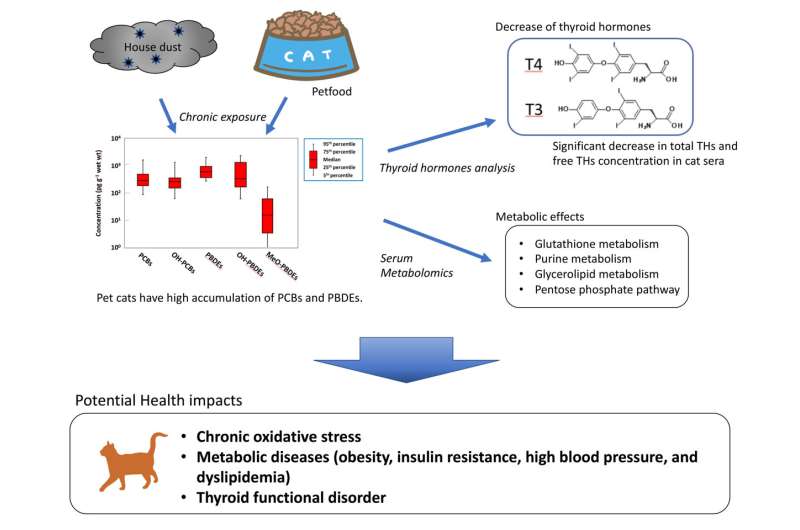Effect of environmental contaminants on the health of pet cats

Companion animals are in close contact with human surroundings, and there is growing concern about the effects of harmful substances on the health of pet cats. This study investigated the potential health effects of organohalogen compounds (OHCs) on thyroid hormone (TH) homeostasis and metabolomics in pet cats in Japan. There was a significant negative correlation between concentrations of several contaminants, such as polychlorinated biphenyls (PCBs), polybrominated diphenyl ethers (PBDEs), hydroxylated PCBs (OH-PCBs), hydroxylated PBDEs (OH-PBDEs), and total THs (L-thyroxine, 3,5,3'-triiodo-L-thyronine, and 3,3,'5'-triiodo-L-thyronine) in cat serum samples. These results suggested that exposure to OHCs causes a decrease in serum TH levels in pet cats.
In this metabolomics study, each exposure level of parent compounds (PCBs and PBDEs) and their hydroxylated compounds (OH-PCBs and OH-PBDEs) were associated with their unique primary metabolic pathways, suggesting that parent and phenolic compounds exhibit different mechanisms of action and biological effects. The OPLS-DA revealed that concentrations of 13 metabolites had four negative or nine positive correlations with PCB concentrations in pet cat serum samples. The concentrations of 16 metabolites exhibited five negative or 11 positive correlations with total OH-PCBs concentrations. In contrast, of the 16 metabolite concentrations, two had negative and 14 had positive correlations with PBDEs concentrations in pet cat serum samples. Of the concentrations of 12 metabolites, two exhibited negative and 10 exhibited positive correlations with OH-PBDEs concentrations. PCBs were associated with many metabolic pathways, including glutathione and purine metabolism. These results demonstrated that OHC exposure causes chronic oxidative stress in pet cats. PBDEs were positively associated with alanine, aspartate, and glutamate metabolism. Due to the chronic exposure of cats to mixtures of these contaminants, the combination of their respective metabolic pathways may have a synergistic effect.
These results indicate it is necessary to pay specific attention to the onset of lifestyle-related diseases due to abnormal lipid metabolism in pet cats. Pet cats have faced lifestyle challenges in recent years, due to the increase in type 2 diabetes and cardiogenic arterial thromboembolism. Providing companion animals with adequate care and an environment with low exposure to OHCs is an important consideration in maintaining the health and well-being of pets. Therefore, it is necessary to reduce the OHC contained in the indoor environment and pet food. In addition, it is essential to clarify the toxic effects of pollutants on pet cats.
More information: Kei Nomiyama et al, Health impact assessment of pet cats caused by organohalogen contaminants by serum metabolomics and thyroid hormone analysis, Science of The Total Environment (2022). DOI: 10.1016/j.scitotenv.2022.156490
Journal information: Science of the Total Environment
Provided by Ehime University





















